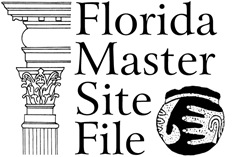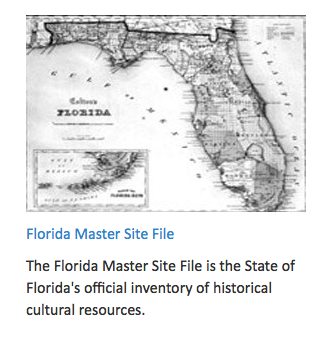Burns Court National Register District
In the City of Sarasota there exist 2 types of historic designation offered to help preserve and recognize the city’s valuable historic resources. One is national designation – listing on the National Register of Historic Places. The other is local designation offered by the City of Sarasota.
Local Designation in Laurel Park
What is confusing and misrepresented as a designation is a listing called the Florida master site file – FMSF for short. It is not an official designation. It is not a designation at all.
FMSF Listing Harbor Acres (built 1948) – demolished
FMSF is a state archive for resources in Florida that are 50 years old or older. It’s simply an inventory. It contains more than 196,000 cultural resources and more than 21,000 manuscripts. Anyone can submit a resource to the FMSF – anyone! For preservation researchers, the FMSF can be a goldmine of information. But for communities who attempt to utilize it as a standard in their local ordinances the FMSF can create quite a quagmire.
It is not consistently updated, submission forms are riddled with inaccurate information and the inventory does not cover all resources in the state or the City of Sarasota that are 50 years or older by any stretch of the imagination. Establishing any review authority based on a list that has no standards and no requirements is extremely problematic.
The City of Sarasota has included the FMSF in their preservation ordinance and uses it as a standard for review almost on par with the City’s locally designated historic properties. This why it is often erroneously referred to as a historic designation.
FMSf listing – built 1950 – yet this is clearly a newer structure and demolition of the original house was never recorded on the fmsf
On the upside – FMSF properties are offered relief from the building code in the City of Sarasota. Listing on the FMSF offers owners virtually all the same exemptions and latitude that the City provides to locally designated property owners such as easy zoning code variances and relief from building codes.
Excerpt from – Zoning Code City of Sarasota
A FMSF property owner can decide whether to go through the City’s review process to take advantage of the perks, while owners of locally designated structures must go through review whenever a building permit is necessary for alterations. I confess, I own a locally designated property and the review is not a big issue – but if you are considering applying to locally designate your property, why would you choose to spend the time and money to do that when you can receive the same benefits by simply listing the property on the FMSF and escape mandatory review? Ah, but you would miss out on the bronze plaque and your property being recognized on a list on the City’s website!
 FMSF property preserved and enlarged through the exemption from the 50% rule
FMSF property preserved and enlarged through the exemption from the 50% rule
The pièce de résistance of inclusion on the FMSF in the past was if you owned a property listed on the FMSF that is in a flood zone, the property was automatically, without review by the City’s HP advisory board or the administration, exempted from the 50% rule and substantial improvement. You could add on without elevating the new addition saving thousands in the construction cost to elevate! Many very small, functionally obsolete cottages on great pieces of waterfront which would ordinarily be bulldozed were preserved because of this.
Indian Beach Lane – Built 1935 – Not on the FMSF
On the downside – property owners whose property has been listed on the FMSF face a rude awakening if they wish to demolish their building. The city requires a review of the building by the City’s historic preservation planner. The City has the right to impose a stay of 120 days and require mitigation.The City may and often does require the owner appear before the City’s Historic Preservation Advisory Board, hire a preservation professional to document the building history, get quotes from a certified house mover for relocation of the structure and quotes from a salvage company to remove anything that can be repurposed. The City also charges an additional fee for a FMSF structure to be demolished, over an above the demolition fee.
House on left FMSf (built 1938) – House on right is not FMSF (Built 1951)
For property owners the biggest problem is they likely don’t even know their property may be on the FMSF. No one notifies you when it is listed. The City doesn’t publicize or promote it. It’s not in your deed, its not part of the property appraiser’s information on your property. You have to be savvy enough to know the list exists. For years the only way to find out was to contact the state’s preservation office. More recently, the City has put the FMSF list on their website.
House on left is FMSF (built 1915) – House on Right is not FMSF (built 1950)
What is shameful is the condition of Sarasota’s FMSF list. It is not maintained, not regularly updated and it is far from being comprehensive. By using the FMSF list to regulate what properties in our city can receive valuable relief from the building code and what properties may be subject to a demolition stay and the added expenses to mitigate before demolishing a structure are incredibly unfairly applied. While your 1964 house may be on the FMSF it is quite possible your neighbor’s house built in1936 is not. Many old properties have been overlooked. Many properties have not been surveyed. If the city code is to be fairly applied then all properties built before 1965 need to be listed on the FMSF.
House built in 1980 is ERRONEOUSLY listed on the FMSF
Owners of individually designated and contributing properties in the City’s National Register Districts have a somewhat unique situation. The City’s preservation ordinance and code pertain to locally designated individual resources and locally designated districts. The City’s zoning code does not regulate nationally designated properties or districts except in one, and only one section of the code – Section IV-822.
 In 2009 the City amended the zoning code to be able to administratively regulate national register historic resources individually and within a national district.
In 2009 the City amended the zoning code to be able to administratively regulate national register historic resources individually and within a national district.
More than likely your nationally designated property whether individually designated or contributing to a national district is also on the FMSF. Your historic property is subject to whatever regulations the City has mandated for FMSF listings.
National Register of historic places Contributing Structure
So when you and your neighbors agreed to have your neighborhood designated a national register district and were told the designation would not impose any obligation on your property, or restrict your basic right to use and dispose of the property as you see fit that was and is true from a national /federal level. It is not true from a local level. As is the case here, the City of Sarasota considers your property a FMSF listing and has amended the zoning code to regulate your historic resource.
434 S. ORANGE – BUILT 1946 – NOT ON THE FMSF
So how exactly does a property get on the FMSF? Over the years the City has hired consultants to do windshield surveys of the City’s historic resources in specific neighborhoods around the City. Some of the listings are done fairly thoroughly, others not so. As national districts are proposed and their resources identified, they too are added to the FMSF. Individuals can also add properties to the list. It is the responsibility of the City to maintain the city’s FMSF listings.
Dolphin Street Structure circa 1902 – Demolished but FMSF listing Remains
Can a property be removed from the FMSF list? Nope. According to the State Historic Preservation Office ” The FMSF holds public information gathered, processed, and organized partly or wholly at public expense. Granting such requests would be similar to deleting public tax records at the taxpayer’s request.”
You can request information about a particular FMSF listing by contacting the State Historic Preservation Office via email: sitefile@dosmyflorida.com. The office is extremely helpful and quick to respond.
FMSF forms are also available online if you wish to file one for your 50 + year old resource. For more information on the Florida master site file visit: http://dos.myflorida.com/historical/preservation/master-site-file/














